The coldest place in the Universe?
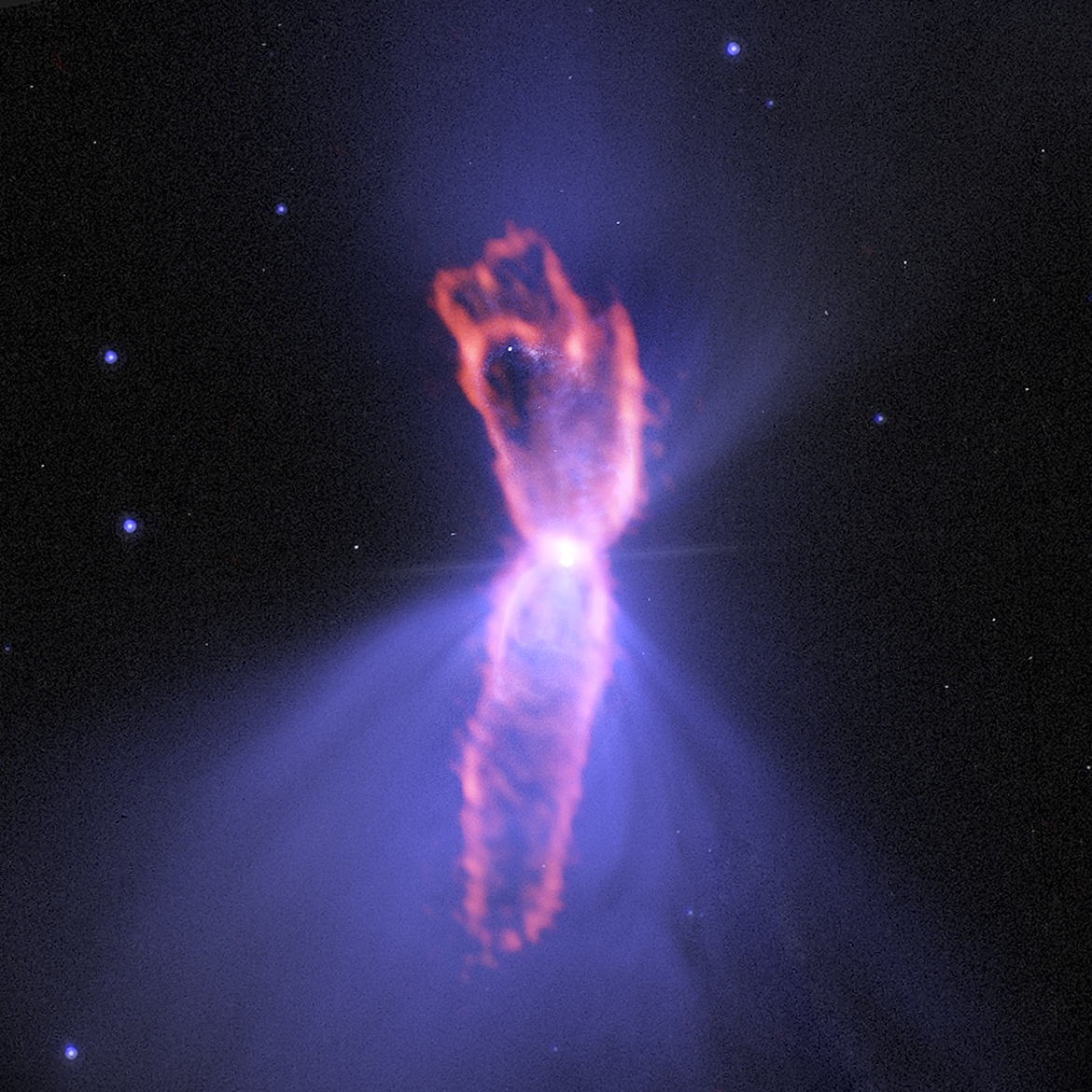 This remarkable image of the Boomerang Nebula shows an hour-shaped
outflow of gas and dust coming from a dying red giant star. ALMA observations
that were processed using CASA have revealed the presence of an
ultra-cold gas outflow, induced when a companion star plunged into the
red giant. This outflow is expanding and cooling so rapidly that
its temperature has fallen below the temperature of the micro-wave
background. The red hour-shaped feature is CO(3-2) emission that has
been swept up by a jet from the inner regions of the ultra-cold
outflow. The blue haze represents scattered light imagesd with HST.
This remarkable image of the Boomerang Nebula shows an hour-shaped
outflow of gas and dust coming from a dying red giant star. ALMA observations
that were processed using CASA have revealed the presence of an
ultra-cold gas outflow, induced when a companion star plunged into the
red giant. This outflow is expanding and cooling so rapidly that
its temperature has fallen below the temperature of the micro-wave
background. The red hour-shaped feature is CO(3-2) emission that has
been swept up by a jet from the inner regions of the ultra-cold
outflow. The blue haze represents scattered light imagesd with HST.
Credit: ALMA (ESO/NAOJ/NRAO); NASA/ESA Hubble; NRAO/AUI/NSF
ALMA
Media release
Publication:
R. Sahai, W. H. T. Vlemmings, and L-A. Nyman: "The Coldest PLace in
the Universe: Probing the Ultra-cold Outflow and Dusty Disk in the
Boomerang Nebula", 2017, ApJ, 841, 110
ALMA images the Sun
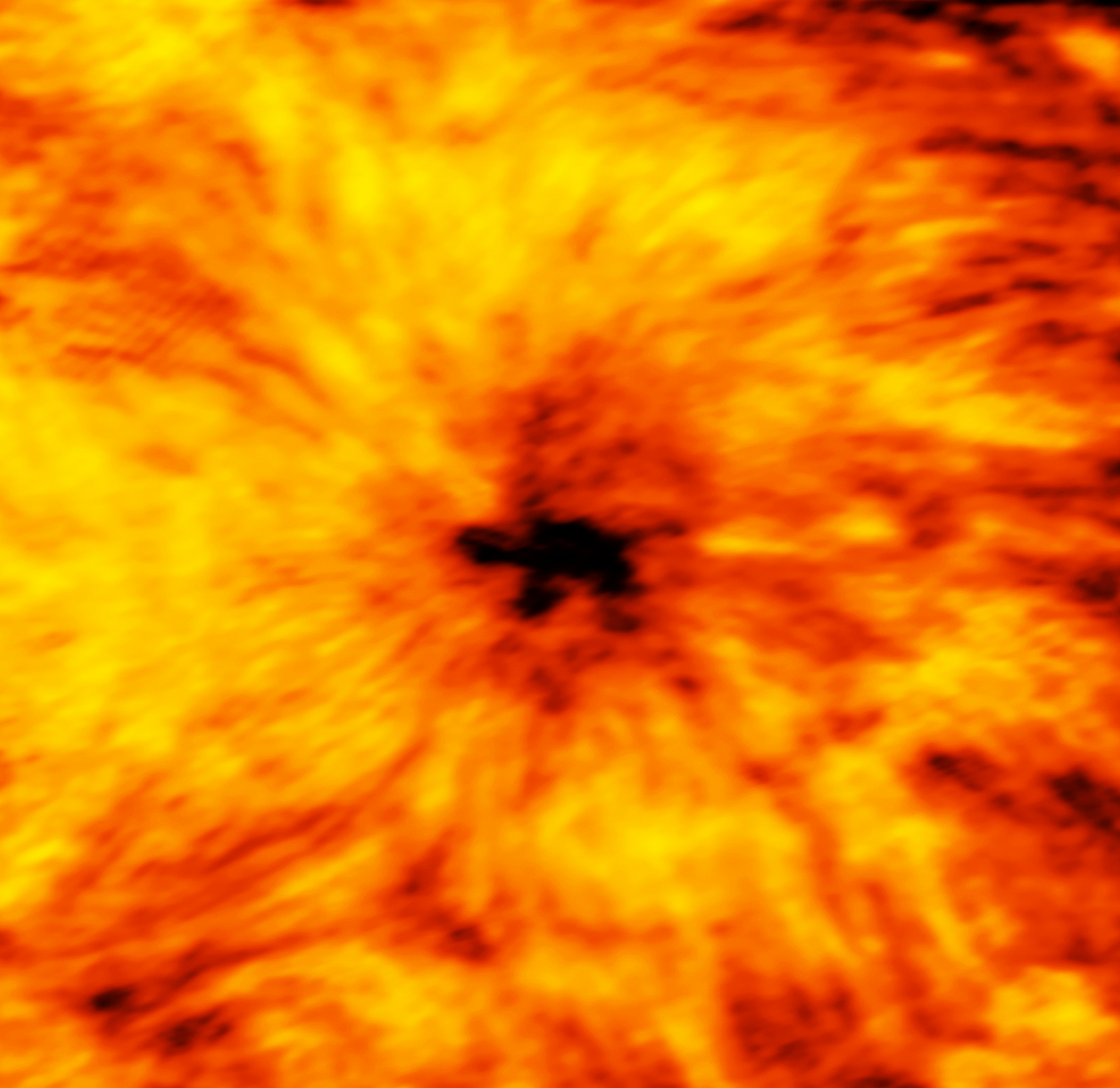 A new image taken with ALMA and reduced with CASA reveals stunning
details of our Sun, including an evolving sunspot that is nearly twice
the diameter of the Earth. This image was taken as part of ALMA's
solar commissioning campaign. It captures the millimeter-wavelength
light emitted by the Sun's chromosphere - the region that lies just
above the photosphere, the visible surface of the Sun. The Sun is much
brighter and larger than the distant objects that ALMA typically
observes. Therefore, the solar commissioning team not only had to
develop special procedures to enable ALMA to safely image the Sun, but
also faced challenges in terms of data reduction in CASA. More details of
this can be read in our recent CASA Newsletter.
A new image taken with ALMA and reduced with CASA reveals stunning
details of our Sun, including an evolving sunspot that is nearly twice
the diameter of the Earth. This image was taken as part of ALMA's
solar commissioning campaign. It captures the millimeter-wavelength
light emitted by the Sun's chromosphere - the region that lies just
above the photosphere, the visible surface of the Sun. The Sun is much
brighter and larger than the distant objects that ALMA typically
observes. Therefore, the solar commissioning team not only had to
develop special procedures to enable ALMA to safely image the Sun, but
also faced challenges in terms of data reduction in CASA. More details of
this can be read in our recent CASA Newsletter.
Credit: ALMA (ESO/NAOJ/NRAO)
NRAO
Media Release
Publication:
M. Shimojo, T. Bastian, A. Hales, et al., "Observing the Sun with
the Atacama Large Millimeter/submillimeter Array (ALMA):
High-Resolution Interferometric Imaging", Solar Physics, 292, 87.
From NVSS to VLASS
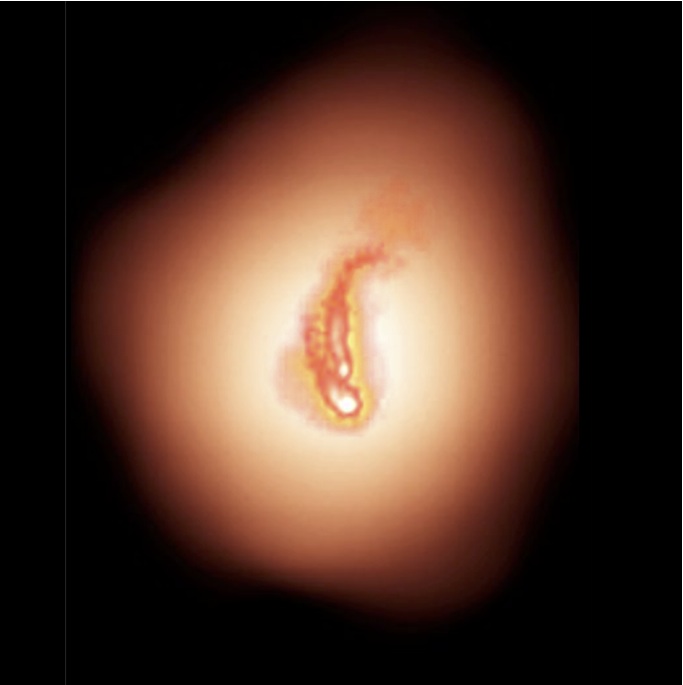 The Karl G. Jansky Very Large Array has embarked on new survey
of the sky, the VLA Sky Survey (VLASS). VLASS wil make three complete
scans of 80 percent of the entire sky at 2-4 GHz over the course of the next 7
years. VLASS is the third major survey of the
VLA, following the NRAO VLA Sky Survey (NVSS) and Faint Images of the
Radio Sky (FIRST). The image on the left visualizes the increase
in resolution of VLASS compared to NVSS and FIRST. Shown is an overlay
of the same pair of radio sources observed with NVSS (orange background
"blob"), FIRST (yellow/orange emission in the center) and VLASS (red/white image in
the center). The resolution increases from 45 arcsec in NVSS to 5
arcsec in FIRST to 2.5 arcsec in VLASS. The vast amounts of data that
will be collected for VLASS will be reduced and imaged with CASA
trhough a dedicated software pipeline. Astronomers expect the VLASS to discover powerful cosmic explosions,
dust-enshrouded stars and galaxies, cosmic magnetic fields, and powerful jets of relativistic
particles eminating from supermassive black holes..
The Karl G. Jansky Very Large Array has embarked on new survey
of the sky, the VLA Sky Survey (VLASS). VLASS wil make three complete
scans of 80 percent of the entire sky at 2-4 GHz over the course of the next 7
years. VLASS is the third major survey of the
VLA, following the NRAO VLA Sky Survey (NVSS) and Faint Images of the
Radio Sky (FIRST). The image on the left visualizes the increase
in resolution of VLASS compared to NVSS and FIRST. Shown is an overlay
of the same pair of radio sources observed with NVSS (orange background
"blob"), FIRST (yellow/orange emission in the center) and VLASS (red/white image in
the center). The resolution increases from 45 arcsec in NVSS to 5
arcsec in FIRST to 2.5 arcsec in VLASS. The vast amounts of data that
will be collected for VLASS will be reduced and imaged with CASA
trhough a dedicated software pipeline. Astronomers expect the VLASS to discover powerful cosmic explosions,
dust-enshrouded stars and galaxies, cosmic magnetic fields, and powerful jets of relativistic
particles eminating from supermassive black holes..
Credit: Bill Saxton, NRAO/AUI/NSF (adapted from its original version)
Sphere of debris around the giant star U Antliae
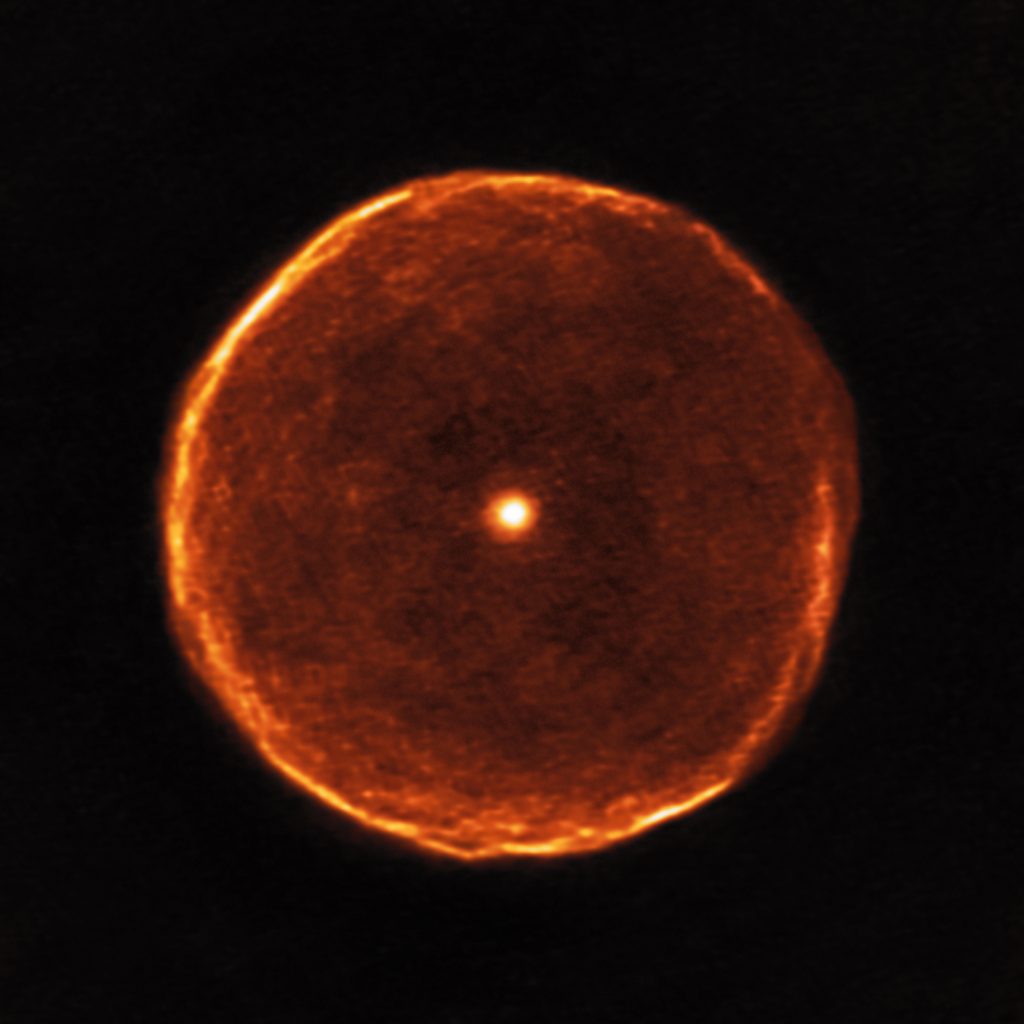 The ageing giant star 'U Antliae' lies roughly 900 light-year from
Earth. Using the Atacama Large Millimeter/submillimeter Array (ALMA),
a team of astronomers has imaged a huge sphere of
debris around this giant star. This is not an extraterrestrial civilization
that blow up its star system... What happened is that around 2,700
years ago, U Antliae went through a short period of rapid mass loss,
ejecting cold gas out into space at high speeds. The image shows a
shell of carbon-monoxide, or CO. Outbursts like these
can enrich star systems with chemical compounds like carbon and oher
elements. The team used relied on the CASA pipeline for calibrating the data,
and used CASA's flexibility for customizing the final imaging as well
as adding single-dish data to recover the overall structure of the
debris shell.
The ageing giant star 'U Antliae' lies roughly 900 light-year from
Earth. Using the Atacama Large Millimeter/submillimeter Array (ALMA),
a team of astronomers has imaged a huge sphere of
debris around this giant star. This is not an extraterrestrial civilization
that blow up its star system... What happened is that around 2,700
years ago, U Antliae went through a short period of rapid mass loss,
ejecting cold gas out into space at high speeds. The image shows a
shell of carbon-monoxide, or CO. Outbursts like these
can enrich star systems with chemical compounds like carbon and oher
elements. The team used relied on the CASA pipeline for calibrating the data,
and used CASA's flexibility for customizing the final imaging as well
as adding single-dish data to recover the overall structure of the
debris shell.
Credit: ALMA (ESO/NAOJ/NRAO)/F. Kerschbaum
ALMA Media Release
Publication:
F. Kerschbaum, M. Maerker, M. Brunner, et al., "Rings and
filaments: The remarkable detached CO shell of U Antliae", A&A,
605, 116.
Einstein-ring of distant lensed galaxy
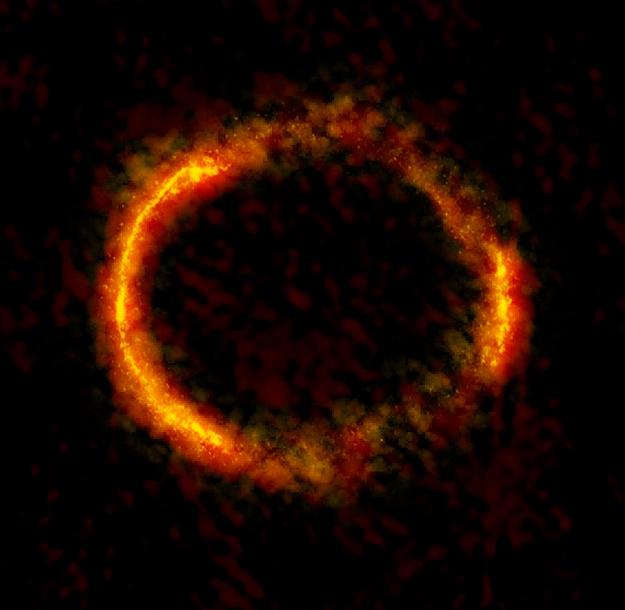 This image shows a galaxy that is 12 billion light-years away, seen at a time when the Universe
was only 15 percent of its current age. Its ring-shape appearance is
the result of its light being bent by a massive foreground galaxy (not visible
in this image), which acts like a cosmic lens. The result is a
so-called Einstein ring, revealed by glowing dust and molecular gas within the
galaxy. This image is the highest resolution image made to date with
the Atacama Large Millimeter/submillimeter Array (ALMA). The CASA
software was required for reducing and imaging these challanging ALMA data.
This image shows a galaxy that is 12 billion light-years away, seen at a time when the Universe
was only 15 percent of its current age. Its ring-shape appearance is
the result of its light being bent by a massive foreground galaxy (not visible
in this image), which acts like a cosmic lens. The result is a
so-called Einstein ring, revealed by glowing dust and molecular gas within the
galaxy. This image is the highest resolution image made to date with
the Atacama Large Millimeter/submillimeter Array (ALMA). The CASA
software was required for reducing and imaging these challanging ALMA data.
Credit: ALMA (NRAO/ESO/NAOJ); B. Saxton, NRAO/AUI/NSF
NRAO
Media Release
Publication:
ALMA Partnership, C. Vlahakis, T. Hunter, et al., "ALMA Long
Baseline Observations of the Strongly Lensed Submillimeter Galaxy
HATLAS J090311.6+003906 at z=3.042", ApJL, 808, 4.
ALMA and VLA zoom in on planet Formation
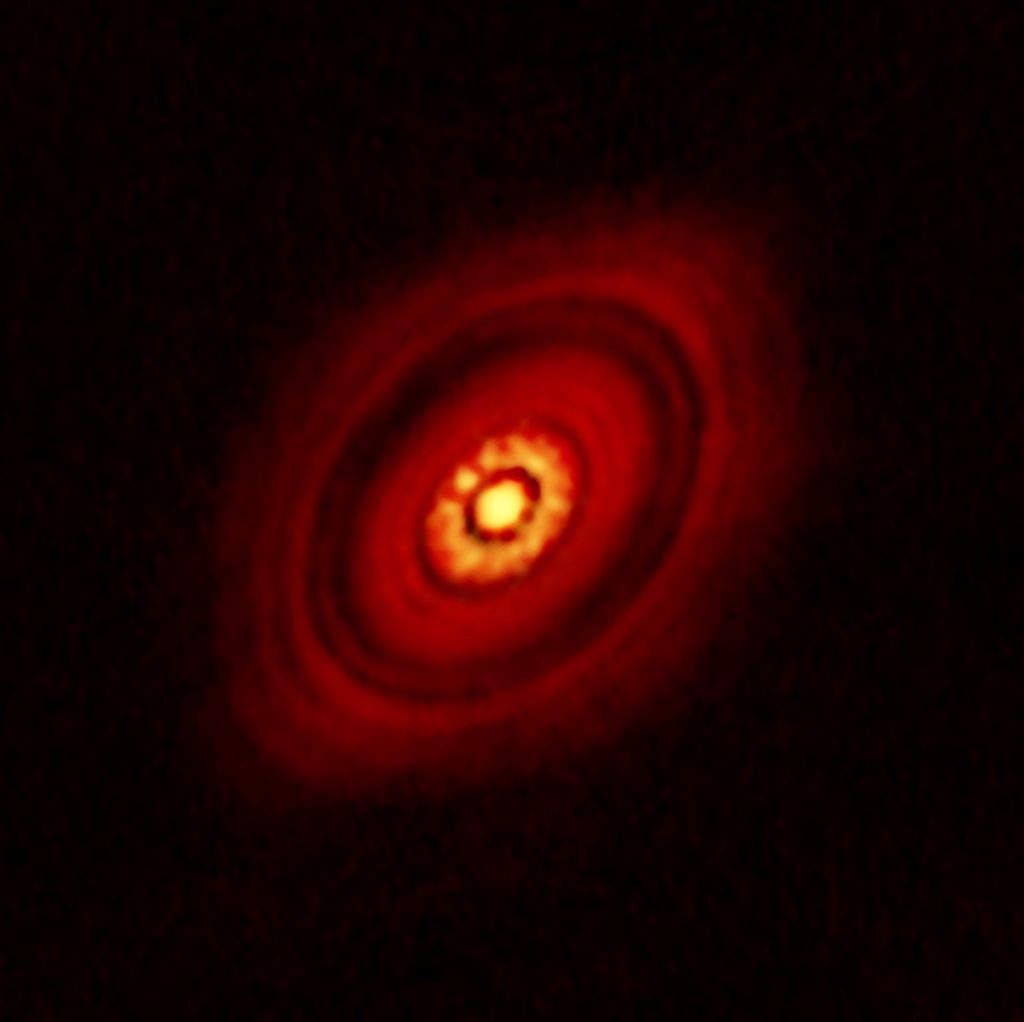 ALMA, VLA and CASA have teamed up to provide this stunning image of HL
Tau, a system that astronomers think may reflect the very earliest
stages in the formation of planets. The Atacama Large
Millimeter/submillimeter Array (ALMA) observed this intriguing system
in 2014, while testing ALMA for operating at its highest
resolution. Subsequent observations with the Karl G. Jansky Very Large
Array (VLA), as shown by the central yellow feature, were needed to image clumps of dust in the very
central region out of which planets similar to our Earth may form.
ALMA, VLA and CASA have teamed up to provide this stunning image of HL
Tau, a system that astronomers think may reflect the very earliest
stages in the formation of planets. The Atacama Large
Millimeter/submillimeter Array (ALMA) observed this intriguing system
in 2014, while testing ALMA for operating at its highest
resolution. Subsequent observations with the Karl G. Jansky Very Large
Array (VLA), as shown by the central yellow feature, were needed to image clumps of dust in the very
central region out of which planets similar to our Earth may form.
Credit: Carrasco-Gonzalez, et al.; Bill Saxton, NRAO/AUI/NSF
NRAO
Media Release
Publications: Carrasco-Gonzalez, C. Henning, C. Chandler, et al. "For the survey, the VLA will receive cosmic radio emissions at frequencies between 2 and 4 GigaHertz,", ApJL,
821, 16
ALMA Partnership, C. Brogan, L. Perez, et al. "The 2014 ALMA Long
Baseline Campaign: First Results from High Angular Resolution
Observations toward the HL Tau Region", ApJL, 808, 3.

